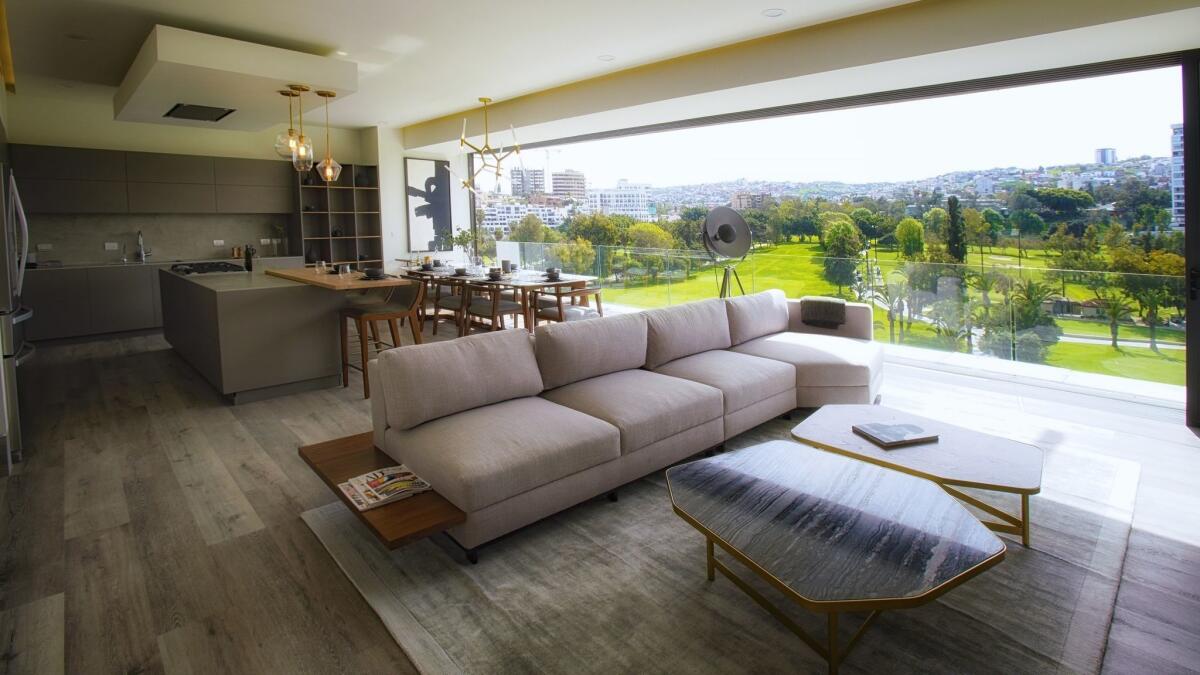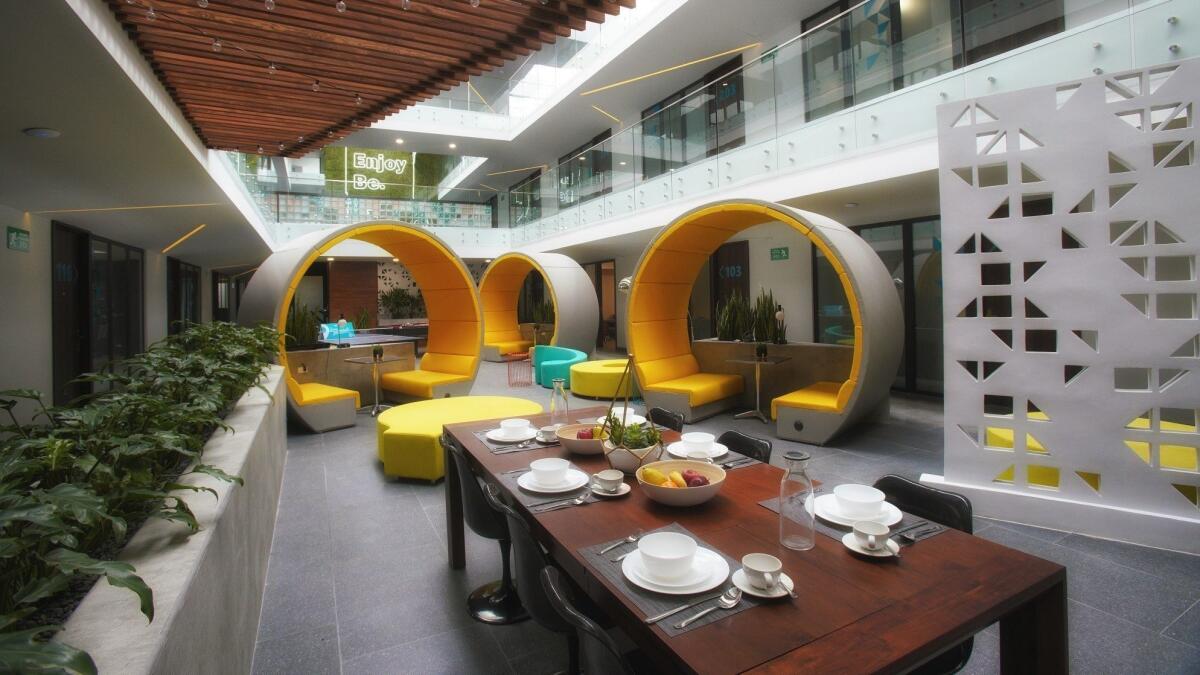New Tijuana condo towers will hit record heights

- Share via
Blink and you might have missed a drastic change to Tijuana’s skyline.
The Mexican city continues to transform as the rush for condos fuels new high-rises, including the tallest building in its history to be completed by the end of the year.
There are roughly 400 new condos opening in 2019, with most squeezed into abandoned lots around the city’s exclusive golf course. Similar to San Diego, land constraints are pushing planners to strive for higher density and stoking tension in already congested areas.
Since 2016, at least 1,000 new condos and apartments over 30 residential buildings have risen across Tijuana. Seventeen of the city’s 20 tallest buildings were constructed in the last decade and there’s no slowdown in sight.
The city’s growth has been overshadowed by news stories that have propelled the city onto the international stage. Images of Central American migrants overwhelming the city and a staggering murder rate — a record 2,518 homicides in 2018 — have dominated most news coverage.
However, economically, things are looking up. New President Andrés Manuel López Obrador has introduced an economic “free zone” along the border that increases the minimum wage and reduces income taxes. For affluent Mexicans already in the city, there are more housing options than ever before.
The crown jewel of the city’s growth this year is the 32-floor Sayan Campestre next to the city’s central golf course, Club Campestre de Tijuana. When it is completed in December, the 395-foot tower will become the city’s tallest building — unseating a condo tower constructed in 2008, the NewCity Diamond Tower, by roughly 60 feet.
Sayan Campestre will be arguably the most high-end place to live in the city, with access to the golf course, valet parking, a car wash, outdoor gardens, a gym and spa, childcare, a sports bar, two to three parking spots for every condo, a park-style outdoor space overlooking the golf course with Armani furniture, and plenty of security.
Costs for the units range from $450,000 to $1.35 million, making it the most expensive of all Tijuana developments. Views from units are of the golf course, considered one of the most ideal locations in the city because of its exclusive access.
Much of the residential development the past few years has surrounded the golf course and it is beginning to look a bit like New York’s Central Park where high-rise development surrounds open space. Unlike New York City, the general public does not have free access to the green area, further illustrating the divide between the rich and poor in the city.
Sayan, based in Puerto Vallarta, is spending about $35 million on Sayan Campestre, said Rodolfo Aguilar, architect and partner in the project. To make sure they didn’t go broke on such an expensive project, the plan was to sell 35 percent of the condos in eight months. They sold 40 percent in the first month.
“We realized there was a lot of need for this,” Aguilar said, as he strode across the dusty concrete frame recently of a soon-to-be posh residential tower.
About 420 laborers grind away daily at the concrete frame, using heavy machinery to dig its parking structure, carry endless rows of pipes and otherwise completely transform the site, a burned down seafood restaurant. Their furious pace comes to a halt around noon when workers bring back food from street trucks and restaurants, and the smell of carne asada permeates the site.
By December, a sleek silver building with balconies for new residents to look across the city will be in its place.
To understand what is happening in Tijuana right now, you have to go back to the Great Recession, which was bad across the border in San Diego County, but just as dreadful in Mexico. Residential construction slowed considerably, which real estate workers say meant a lot of built-up demand later.
“In 2007, Tijuana was in a coma,” said Sergio Arturo Gonzalez, business developer for the real estate agency Probien Bienes Exclusivos . “Nobody built anything.”
Almost all new buyers are affluent Mexicans who either saved up when there weren’t a lot of homes to buy or who had good paying jobs in the United States. In other cases, Mexican-Americans are buying after deciding to retire in Tijuana, say real estate agents. Also, people who want a home-away-from-home because they are in the city frequently are also becoming owners.
Additional development around the golf course includes the 38-unit Liv La Recta project and the 120-unit Levant Campestre, both opening in early to mid-2020.
Levant Campestre has one to three bedroom condos that range from 869 square feet to 1,776 square feet. Costs start around $167,000 and go up to $314,000. The 18-story building from Monterrey, Mexico-based Insar is also heavily focused on amenities with a pool, child play area, clubhouse, concierge, game room, outdoor space looking over the golf course and a joint basketball court/soccer field.
Levant project leader Adriana Gaxiola said 70 percent of the 120 units have sold and most buyers have been Mexican, but there have been a few Mexican-Americans.
Liv La Recta has condos from 1,603 square feet to 2,895 square feet, with costs starting at $350,000 and going up to $500,000. Even though the building is also 18 stories, it only has 38 units, meaning fewer owners in the building.
Nallely Garcia, commercial manager for developer Urban Living, said 17 condos had sold so far with all buyers being Mexican and many of them being retirees. She said older buyers told her that they want to give their current homes to their children so they are down-sizing in the high-end condo.
Liv has also had plenty of amenities to woo buyers, such as a gym, pool, roof terrace and garden, concierge, closed circuit cameras and event room.
The project is from Tijuana-based Urban Living, which is one of the biggest developers in the city. Their projects, all at different stages of development, include eight office buildings, five hotels, four residential towers and two mixed-use developments.
Mixed-use
Like San Diego, there is a lot of need for buildings that mix multiple uses because of limited land. While on a much smaller scale, Tijuana has also seen more proposals for mixed-use buildings and adoption of co-working ideas.
With that in mind, Cosmopolitan Group opened a hybrid co-working space and apartment building recently — part of its “Eazy Living” brand and named Eazy Rio — in the city’s business district Zona Río. It’s a bit like a WeWork office where people rent a small office space, except you can take a nap in your own apartment during lunch hour.

On one side of the building, 96 apartments rent for around $1,000 a month and are 516 square feet to 645 square feet. The other side of the building, separated by a door that can only be opened with a key, holds 17,760 square feet of office space aimed at startups and companies new to Tijuana.
“No one else offers something where you can work and live at the space place,” said Michael Goldstein, who heads the Eazy Living division. “You could go to the office in your pajamas.”
It costs $99 a month to use an open area of the co-working space where someone could just sit down and turn on a laptop. Rent for a desk is $149 a month and an enclosed office space, where the person doesn’t have to take home materials at the end of the day, goes for $450 a month. That’s about a quarter or less of the prices of similar offerings at WeWork in downtown San Diego.
Goldstein said they have already received interest from several American businesses, many of whom have said they felt overcharged in previous Tijuana office buildings.
Cosmopolitan Group is one of the biggest developers in Tijuana and has been at the center of rising tensions over new construction, recently over a road to a new residential tower. Opposition to its Life condo tower, across the road from Club Campestre de Tijuana, has led to media coverage in local publications such as Frontera, and coordinated protests.
Parents and others are worried about the safety of students on the road leading up to its 45-unit building. It had been used by students of nearby schools for years. The company says it will work with officials to make the students’ path safer, but will not abandon use of the road.
Alameda Otay
A condo in the Alameda Otay development is walking distance from a Caramel Macchiato at a new Starbucks, the latest horror film at Cinemex and Buffalo wings at Porter’s sports pub.
The 40-acre Alameda Otay masterplan community is similar to Chula Vista’s Otay Ranch masterplan in San Diego County — albeit on a much smaller scale — in that it looks very similar and has a mix of residential, retail, some office, one hotel and future plans for more uses. It is east of downtown, away from a lot of the hustle and bustle, and only a few blocks from the city’s main airport.
It is also near the economic engine of the maquiladoras, factories that produce many products purchased in the United States and feature a smorgasbord of foreign investors. Many American and Asian executives who run the maquiladoras have bought condos in Alameda Otay’s housing offering called Magnitud, said Raymundo Arnaiz, a director with housing developer Frasa.
“There is a need for residential around here,” Arnaiz said in during a recent tour.
Magnitud condos range from $154,000 to $220,000, and are 914 square feet to 1,280 square feet. The $12 million first phase of 120 condos will be completed in February 2020, eventually expanding to a total unit count of 240.
There is a lone showroom of a Magnitud condo as the development is just a concrete shell at the moment. It has made enough of an impression that Frasa said half the units have already sold.
In the living room of the condo is a wraparound gray couch facing a flatscreen television and what looks like 1950s Americana accents throughout. A sort of Jackson Pollock-inspired painting with gold, blue and black stripes hangs on the wall. The view out the window is of Magnitud’s concrete frame with workers darting in and out.
Business
[email protected] (619) 293-1891 Twitter: @phillipmolnar
ALSO
San Diego’s new single-family homes are pricey, modern and in short supply
Tijuana condo craze continues in to 2018
Last year’s housing market broke records
More to Read
Sign up for Essential California
The most important California stories and recommendations in your inbox every morning.
You may occasionally receive promotional content from the Los Angeles Times.







